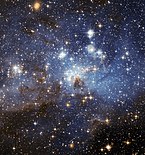보크 구상체
Bok globule| 별의 형성 |
|---|
 |
| 오브젝트 클래스 |
| 이론적 개념 |
천문학에서, Bok 구형은 별 형성이 일어날 수 있는 고밀도 우주 먼지와 가스를 포함하는 고립된 상대적으로 작은 어두운 성운입니다.보크 구상체는 HII 영역 내에서 발견되며, 일반적으로 약 1광년 정도(약 4.547×10m3)[2]의 지역 내에 포함된 약[1] 2에서 50개의 태양 질량을 가지고 있다.수소 분자(H2), 산화탄소 및 헬륨, 규산염 분진 약 1%(질량 기준)를 함유하고 있습니다.Bok globals는 가장 일반적으로 이중성 또는 다중성계를 [3]형성한다.
역사
보크 구형은 1940년대에 천문학자 바트 보크에 의해 처음 관측되었다.1947년에 발표된 기사에서, 그와 에디스 라일리는 이 구름들이 새로운 별들을 형성하기 위해 중력 붕괴를 겪고 있는 "곤충의 고치와 유사하다"는 가설을 세웠는데, 이로부터 별과 성단이 [4][failed verification]탄생했다.이 가설은 짙은 먹구름 내부에서 방출되는 모든 가시광선을 가리는 관찰상의 어려움 때문에 검증하기 어려웠다.1990년에 발표된 근적외선 관측 결과를 분석한 결과, Bok [5]구상체 안에서 별이 태어나고 있는 것으로 확인되었습니다.추가 관측 결과, 일부 Bok 구상체에는 따뜻한 [2]공급원이 포함되어 있으며, 일부는 허빅을 포함하고 있는 것으로 밝혀졌다.Haro 물체,[6] 그리고 어떤 것들은 분자 [7]가스의 유출을 보여줍니다.밀리미터파 방출선 연구는 물질이 축적되는 원시성에 [8]유입된다는 증거를 제공했다.이제 전형적인 Bok 구상체는 약 1광년 정도 지름의 지역에 약 10개의 태양 질량의 물질을 포함하고 있으며, Bok 구상체는 일반적으로 이중성계 또는 다중성계를 [5][9][10]형성한다고 생각된다.
Bok globales는 여전히 집중적인 연구 대상이다.자연계에서 가장 차가운 물체 중 하나로 알려진 그들의 구조와 밀도는 다소 미스터리로 남아있다.지금까지 적용된 방법들은 근적외선 소멸에서 도출된 기둥 밀도와 심지어 이러한 천체들을 더 조사하기 위해 별의 수를 세는 것에 의존해 왔다.
주변의 뜨거운 별에서 자외선을 쬐는 복 구상체는 꼬리를 만들기 위해 물질을 벗겨내는 현상을 보인다.이러한 유형을 "cometary globules"(CG)[11]라고 합니다.
이미지 갤러리
허블 우주 망원경의 WFPC2 기기로 촬영한 HII 영역 IC 2944에 있는 Bok 구상체 세트인 Thackeray's Globules
NGC 281 성운(IC 1590 성단) 내에 위치한 Bok 구상체
바너드 68은 불과 410광년 거리에 있는 가장 가까운 Bok 구상체 중 하나이다.지름은 약 12,500AU(0.198ly) ( km 2조km)
「 」를 참조해 주세요.
레퍼런스
- ^ Michael Szpir (May–June 2001). "Bart Bok's Black Blobs". American Scientist. Archived from the original on 2017-04-24. Retrieved 2008-11-19.
Bok globules such as Barnard 68 are only about half a light-year across and weigh in at about two solar masses
- ^ a b Clemens, Dan P.; Yun, João Lin; Meyer, Mark H. (March 1991). "BOK globules and small molecular clouds – Deep IRAS photometry and (C-12)O spectroscopy". Astrophysical Journal Supplement. 75: 877. Bibcode:1991ApJS...75..877C. doi:10.1086/191552.
- ^ Launhardt, R.; Sargent, A. I.; Henning, T.; Zylka, R.; Zinnecker, H. (10–15 April 2000). "Binary and multiple star formation in Bok globules". Birth and Evolution of Binary Stars, Poster Proceedings of IAU Symposium No. 200 on The Formation of Binary Stars. Potsdam, Germany: Bo Reipurth and Hans Zinnecker. p. 103. Bibcode:2000IAUS..200P.103L.
- ^ Bok, Bart J.; Reilly, Edith F. (March 1947). "Small Dark Nebulae". Astrophysical Journal. 105: 255. Bibcode:1947ApJ...105..255B. doi:10.1086/144901.
- ^ a b Yun, João Lin; Clemens, Dan P. (December 20, 1990). "Star formation in small globules – Bart Bok was correct". Astrophysical Journal Letters. 365: L73. Bibcode:1990ApJ...365L..73Y. doi:10.1086/185891.
- ^ Reipurth, Bo; Heathcote, Steve; Vrba, Frederick (March 1992). "Star formation in Bok globules and low-mass clouds. IV – Herbig–Haro objects in B335". Astronomy & Astrophysics. 256 (1): 225. Bibcode:1992A&A...256..225R.
- ^ Yun, João Lin; Clemens, Dan P. (January 1992). "Discovery of outflows from young stellar objects in BOK globules". Astrophysical Journal Letters. 385: L21. Bibcode:1992ApJ...385L..21Y. doi:10.1086/186268.
- ^ Zhou, Shudong; Evans, Neal J., II; Koempe, Carsten; Walmsley, C. M. (March 1993). "Evidence for protostellar collapse in B335". Astrophysical Journal, Part 1. 404 (1): 232. Bibcode:1993ApJ...404..232Z. doi:10.1086/172271.
- ^ Clemens, D. P.; Yun, J. L.; Heyer, M. H. (1991). "Bok globules and small molecular clouds—Deep IRAS photometry and (C-12)O spectroscopy". Astrophysical Journal Supplement. 75: 877–904. Bibcode:1991ApJS...75..877C. doi:10.1086/191552.
- ^ Launhardt, R.; Sargent, A. I.; Henning, T.; Zylka, R.; Zinnecker, H. (2000). "Binary and multiple star formation in Bok globules". In Reipurth, B.; Zinnecker, H. (eds.). Birth and Evolution of Binary Stars, Poster Proceedings of IAU Symposium No. 200 on The Formation of Binary Stars. p. 103. Bibcode:2000IAUS..200P.103L.
- ^ 혜성구체. 1 형성, 진화, 형태학, B.Lefloch와 B.라자레프, 1994년






